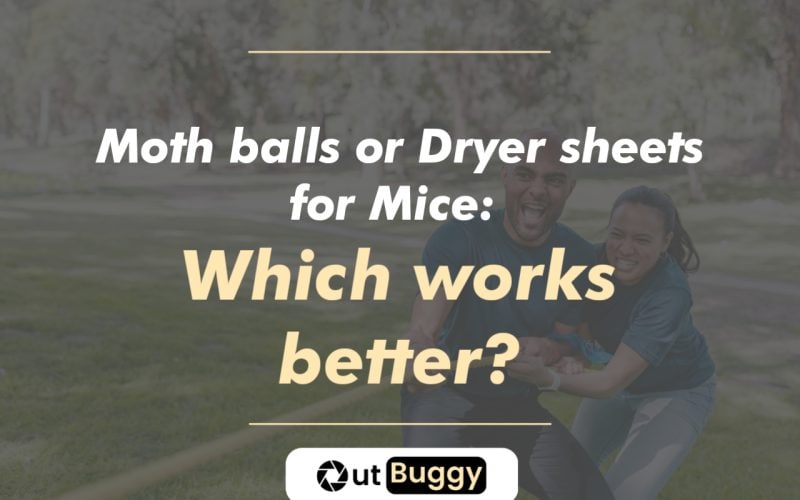Do you have a mouse problem in your home? If so, you’re probably willing to try just about anything to get rid of those pesky rodents. You might have heard of a few different solutions, like using moth balls or dryer sheets. But which one actually works?
In this article, we’re going to take a closer look at both moth balls and dryer sheets as potential deterrents for mice. We’ll explore the science behind each method, examine their effectiveness, and discuss any potential risks or downsides.
Keep reading to find out whether moth balls or dryer sheets are the way to go!
Contents
Moth Balls Or Dryer Sheets For Mice
Two potential solutions that you might have heard of to keep mice away are mothballs and dryer sheets. But do they actually work? Or let’s say, which is more effective?
Let’s start by taking a closer look at each method.
Mothballs are small balls made of a chemical called naphthalene, which has a strong, pungent odor that is intended to repel mice.
The idea is that if you place mothballs in areas where mice are likely to enter your home, the smell will be enough to keep them away.
Dryer sheets, on the other hand, are more commonly used as fabric softeners for laundry. However, some people claim that they also have mouse-repelling properties.
The theory is that the strong scent of the dryer sheets will be enough to deter mice from entering your home.
So which one is more effective?
The truth is, it’s hard to say. While both moth balls and dryer sheets have been used as mouse deterrents for years, there is little scientific evidence to support their effectiveness.
In fact, some studies have even suggested that they may not work at all.
But here’s the truth, these are actually not rat killers, but rather repellents or deterrents.
If you’re gonna refer them to repellents, then, YES, they work.
Here are some reviews to suggest this:

So if you’re willing to give them a try, they might be worth a shot.
Just keep in mind that there are no guarantees, and you may need to try multiple methods before finding one that works for you. For this reason, we created a list of dryer sheets that practically work for mice.
In the next section, we’ll take a closer look at the science behind moth balls and dryer sheets, and examine whether or not they’re actually effective at repelling mice
Science Behind Mothballs And Dryer Sheets
While mothballs and dryer sheets have been used as mouse deterrents for years, the science behind these methods is somewhat murky. Let’s take a closer look at each one.
Mothballs are made of a chemical called naphthalene, which has a strong, pungent odour, one of the things mice hate dearly.
Naphthalene is a toxic chemical that can cause a range of health problems if ingested or inhaled. In fact, the National Pesticide Information Center (NPIC) warns that “mothballs should not be used in living areas where people or pets will be exposed to them regularly.”
In addition, some studies have suggested that moth balls may not be effective at repelling mice.
In a 2006 study published in the journal Pest Management Science, researchers found that naphthalene did actually repel some mice.
What about dryer sheets?
As mentioned earlier, some people claim that the strong scent of dryer sheets is enough to repel mice. However, there is little scientific evidence to support this claim.
One theory is that the strong scent of dryer sheets masks the scent of food and other attractive substances, making it less likely that mice will be drawn to your home.
Also read: Do mice only come out at night?
One other theory is that the chemicals in dryer sheets, such as linalool and benzyl acetate, have some kind of repellent effect on mice.
However, there is very little research to support either of these theories.
In fact, a 2011 study published in the Journal of Economic Entomology found that “none of the volatile compounds tested, including those found in dryer sheets, had a significant effect on the attraction of mice to traps.”
So while some people may swear by dryer sheets as a mouse deterrent, there is little scientific evidence to support their effectiveness.
Plus, like moth balls, dryer sheets come with their own set of potential risks and downsides.
For example, the chemicals in dryer sheets can be harmful to pets and may cause skin irritation or other health problems in humans.
While mothballs and dryer sheets may seem like quick and easy solutions for getting rid of mice, there is little scientific evidence to support their effectiveness. Plus, both methods come with potential risks and downsides, and may even be harmful to your health if not used properly.
If you’re dealing with a mouse infestation, it’s best to consult with a pest control professional who can recommend safe and effective methods for getting rid of the rodents
Potential Downsides Of Using MothBalls Or Dryer Sheets
Now that we’ve discussed the science behind mothballs and dryer sheets as mouse deterrents, let’s take a closer look at some of the potential risks and downsides of using these methods.
First of all, as we mentioned earlier, both moth balls and dryer sheets contain chemicals that can be harmful to humans and pets.
Naphthalene, the main ingredient in mothballs, can cause headaches, nausea, and other health problems if inhaled in large amounts. It can also be toxic if ingested and may cause damage to the liver, kidneys, and central nervous system.
Similarly, the chemicals in dryer sheets can cause skin irritation, respiratory problems, and other health issues if they come into contact with the skin or are inhaled.
In addition to the potential health risks, there are some other downsides to using moth balls and dryer sheets as mouse deterrents. For one thing, these methods may not be very effective in the long run.
As we mentioned earlier, there is little scientific evidence to support the idea that moth balls or dryer sheets can effectively repel mice. Even if they do seem to work at first, mice may eventually get used to the smell and start ignoring it.
Something else to note that is that they can be messy and inconvenient. Mothballs have a strong odour that can linger for days or even weeks, and they can leave behind a powdery residue that can be difficult to clean up. Also, dryer sheets can leave behind a waxy residue that can make surfaces slippery and difficult to clean.
Finally, it’s worth noting that using moth balls or dryer sheets may not be the most environmentally friendly option. Both of these products contain chemicals that can be harmful to the environment if they are not disposed of properly. In addition, using these methods may not be sustainable in the long run, as they may require frequent replacements or reapplications.
Conclusion
The question of whether to use moth balls or dryer sheets for mice is not a simple one. While both methods have their proponents, there is little scientific evidence to support their effectiveness. Moreover, they come with potential health risks and environmental downsides that should not be ignored.
With the right approach, you can keep your home mouse-free without sacrificing your health or the well-being of the planet.



